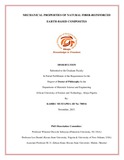| dc.description.abstract | This study presents the results of a combined experimental and theoretical study of the strength, fracture toughness and interfacial properties of natural fiber-reinforced earth-based composite materials. The composites, which consist of mixtures of laterite, clay and straw, are stabilized with
controlled levels of Portland cement. The compositional dependence of compressive, flexural/bend strength and fracture toughness are explored for different proportions of the constituent materials using composites and crack-tip shielding models. The underlying crack-microstructure interactions associated with Resistance-curve behavior is studied using in situ/ex situ optical microscopy. This reveals evidence of crack bridging by the straw fibers. The measured resistance-curve behavior is also shown to be consistent with predictions from small- and large-scale bridging models. The study also presents an experimental investigation on pullout tests of natural fiber (straw) from earth-based matrices. A specially designed single fiber pullout apparatus is used to provide a quantitative determination of interfacial properties that are relevant to toughening brittle materials through fiber reinforcement.
The parameters investigated includes a specially designed high strength earth-based matrix comprising of 60% laterite, 20% clay and 20% cement. The
mediums from which the fibers are pulled includes a control mortar mix without fibers and a mortar mix with 5, 10 and 20 percent fibers by volume. The toughening behavior of whisker-reinforced earth-based matrix is analyzed in terms of a whisker bridging zone immediately behind the crack tip and interface strength. This approach is consistent with microscopy observations which reveal that intact bridging whiskers exist behind the crack tip as a result of debonding of the whisker-matrix interface.
The implications of the results are then discussed for potential applications in the design of robust earth-based building materials for sustainable eco-friendly homes. | en_US |

